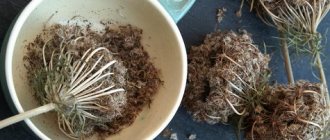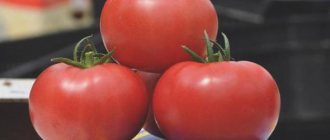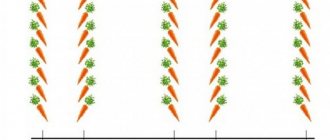Carrots are one of the most common vegetable crops, which many summer residents cultivate in their garden plots. To ensure successful cultivation, it is recommended to choose the variety wisely. It is worth carefully studying the description of the vegetable crop and listening to the reviews of those who have already planted this or that carrot in their dacha. An excellent solution is Vitamin 6. The attractiveness of this variety lies in its high yield, excellent keeping quality and excellent taste of root crops.
[contents]
History of the creation of the variety
The Vitaminnaya carrot variety was bred by breeders of the Research Institute of Vegetable Farming, and the parent forms of the new variety were the Nantes and Amsterdam varieties. This happened back in 1969, after which over the past decades Vitamin carrots have been successfully grown not only in Russia, but also abroad. Today, the variety is recommended for cultivation in Lithuania, Latvia, Belarus, Ukraine, Kazakhstan and all regions of the Russian Federation, with the exception of the North Caucasus region.
Did you know? A small cup of strong coffee can easily be replaced with a glass of freshly squeezed carrot juice, which invigorates and tones the body no worse than a classic black drink.
Description and characteristics
Externally, the roots of Vitaminnaya carrots are in many ways reminiscent of the fruits of other varieties of this vegetable, but if you study its composition more carefully and take a good look at the external features, you can note some specific characteristics of this carrot.
The variety is well resistant to early stemming
Root appearance and yield
The aboveground part of the plant is represented by a semi-erect green rosette of jagged leaves. The root vegetables themselves are cylindrical, blunt-ended, about 15 cm long and 4.9 cm in diameter. The pulp and core are orange, although the central part seems a little lighter. The weight of the root crop is 61–164 g, which depends on the growing conditions and care of carrots. Its taste is always highly appreciated by tasters, largely due to its high level of sweetness.
Medium varieties of carrots also include:
Description of the variety
Carrots are distinguished by the fact that their variety is mid-season, there is a large planting region, it grows almost throughout the entire territory of Russia, and does not grow only in the North Caucasus Federal District. The distinctive characteristics of vitamin carrots have allowed it to become popular among domestic vegetable growers:
- It has a cylindrical shape, with a slightly blunt and rounded end;
- Vitamin 6 carrots, when ripe, weigh from 60 to 200 grams;
- The length of ripe carrots is up to 20 cm, the average is 15 cm;
- Diameter up to 5 cm;
- Unusual tender and quite sweet pulp;
- The color is pronounced orange, with a slight red tint;
- Small round or star-shaped core;
- Sometimes contains more than 10% fructose, the average value is 7-11%;
- High content of beta-carotene in 100 grams of product is 17-22 mg, in other varieties an average of 8-9 mg;
Unique features of its kind allow it to be used in almost everything; it is consumed uncooked due to its high sugar and carotene content, preserved for long-term preservation, and it does not matter whether it comes from the garden or has already been heat treated. Even after lying in a jar in the basement for a long time, or when frozen, it retains its beneficial properties and remains delicious.
A semi-erect leaf rosette will allow gardeners to quickly identify carrots in the garden, and due to the fact that almost all of the root crop is in the ground while it ripens, its head does not take on a green tint.
IMPORTANT: the variety is well resistant to early stemming.
Origin and development of carrots
The variety was first zoned in 1969; the variety was bred by members of the Scientific Research Institute of Vegetable Farming in Russia. It began to spread widely a couple of years after the first planting.
Ripening time and yield
Carrots are mid-season varieties and grow in a period of 90 to 120 days. The variety provides vegetable growers with a yield of 4 to 10 kg/sq. m. which is a pretty good result.
Composition of carrots and taste
The sweetness of the fruits of the described variety directly depends on the amount of fructose contained in the pulp, the share of which is 7–11% (for comparison, other varieties can boast only 5% of this substance). In addition, the vegetable contains no less useful beta-carotene: 17–22 mg for every 100 g of product (in other varieties it is no more than 9 mg).
Important! In order for the carrots you eat to bring maximum benefits to the body, you should not expose the fruits to prolonged heat treatment. When exposed to high temperatures, a significant portion of vitamins and minerals are lost.
Variety immunity to diseases
Unfortunately, Vitamin carrots are not characterized by high levels of resistance to diseases and pests , so when growing them, you will have to pay considerable attention to the prevention of fruit rot and the invasion of carrot flies. As a last resort, if it was not possible to prevent the problem, it is important to deal with it in a timely manner, preventing mass spread throughout the garden.
Main characteristics of “Vitamin” carrots
According to the description of the breeders, “Vitamin 6” carrots have good characteristics.
Productivity and scope
“Vitaminnaya” carrots are mid-season. It takes up to 100 days for root crops to ripen. The variety is characterized by cold resistance and high yield. From 1 m², gardeners harvest up to 10 kg of vegetables. Using some techniques, crop productivity can be increased.
- High-quality seed material germinates quite quickly. For this reason, you should buy seeds from a well-known manufacturer of “Vitamin” carrot seeds that you can trust.
- Soaking the seeds will speed up germination.
- Choose a lighted place for planting. You cannot plant a crop in the same bed all the time. The likelihood of pest damage increases.
- Before carrots emerge, plantings are watered regularly. Then moisten the soil once a week.
- After germination, agrotechnical measures are carried out: loosening, weeding, thinning. To ensure a large harvest, the distance between adjacent rows is 30 cm, and between carrot shoots - up to 6-8 cm.
- The crop responds well to fertilizers. In the fall, add organic matter. In spring - rotted manure, compost, or mineral fertilizers.
- Growth stimulants increase productivity.
The variety has universal application. Consumed raw. Goes for processing and storage.
Sustainability
According to the description of the breeders, the “Vitaminnaya” carrot variety is resistant to bolting and cracking. According to other sources, up to 20% of the crop may crack.
The variety tolerates frost and drought well. Even seedlings successfully survive temperature drops to –4˚С. It is for this reason that this variety can be used for pre-winter sowing.
"Vitamin 6" is not highly resistant to pests. When choosing this variety for cultivation on their site, summer residents should be prepared to take preventive measures against insect pests.
Advantages and disadvantages of the variety
According to reviews from originators and summer residents, “Vitamin 6” carrots have a number of advantages.
- Carrots are unpretentious. It is grown even in the northern regions.
- It has high productivity.
- Good keeping quality of root crops.
- The taste characteristics are excellent.
Disadvantages include:
- possibility of cracking;
- no resistance to pests and diseases.
Positive qualities and possible disadvantages
The main difference between Vitaminnaya carrots and other varieties is their richer vitamin and mineral composition and rich color , but this is only the beginning in the list of all the positive characteristics of this plant.
- Other advantages of the vegetable include:
- high yield rates;
- the possibility of growing in different regions of the Russian Federation (even in the northern territories);
- comparative ease of care;
- high taste properties and the same juiciness indicators;
- Possibility of long-term storage without loss of marketability and taste.
- As for the disadvantages, the most noticeable ones when growing root vegetables are:
- low resistance to diseases and pests;
- tendency for ripe carrots to crack.
Prevention and timely harvesting will help solve these problems, so cultivating carrots can bring extremely positive experiences.
Features of cultivation and care in open ground
Vitaminnaya carrot seeds can be sown immediately in open soil , which is where the long process of growing it begins. However, in order for the seeds to germinate faster and the further development of the plant to proceed properly, it is important to properly prepare the planting material and choose the best time for sowing.
Find out more about the features and rules for sowing carrots in open ground.
Optimal timing and conditions for sowing
Sowing Vitamin carrots can be done in early spring, shortly after the snow melts . However, in case of severe winter frosts, it is advisable to wait until the soil warms up to +7...+8°C, which often occurs in mid-April.
A few weeks before this moment, it is worth preparing the substrate and organizing suitable beds, having previously fertilized them with organic mixtures: for example, half a bucket of compost or the same amount of humus per 1 m². On heavy loamy soils, it is also worth using a small amount of wood ash.
Important! Fresh manure is not suitable for fertilizing beds; it must be rotted.
Seeds can only be sown in well-loosened and slightly moistened soil , which will facilitate easy germination of the planting material. Clogged and dry soils will not give good results and most likely the seeds simply will not germinate.
Video: Sowing carrot seeds Vitamin
The process of preparing seeds for sowing
Preparing seeds of this variety for sowing is based on the same steps as when cultivating other varieties of carrots, and the main steps will be the following:
- Soaking in warm water for 1–1.5 days (it is better to put the seeds in separate gauze bags and constantly monitor their moisture, rinsing with warm clean water every 5–7 hours).
- Germination in damp cloth in a warm room. After the first small sprouts appear on the laid out seeds, they need to be dried a little, and then immediately planted in the garden bed, in previously prepared furrows.
- Biostimulation of seed growth using a solution of complex fertilizers (for example, sodium gutamate or the drug “Epin”), in which the seeds are soaked for 10–12 hours. After the specified time, all that remains is to dry the planting material (to a free-flowing state) and you can sow it on the garden bed.
- Disinfection of wet seeds (ungerminated). This is done using a weak solution of potassium permanganate, in which they are kept for about 10–15 minutes, or a solution of boric acid (1 g per 5 liters of water), where the future carrots are left for a day.
- Hardening of seeds to increase their resistance to frost. After soaking, the planting material is moved to a cool place, and then to the vegetable compartment of the refrigerator, keeping it in both places for 12 hours. Hardening is only relevant for pre-soaked and swollen seeds, but with sprouted seeds you should skip this stage.
- Sparging is the most difficult of all the preparatory stages presented, since it requires an aquarium compressor. It is lowered into a container with liquid and uniform operation is ensured, ensuring the same uniform movement of seeds in the jar. On average, the process should last 18–24 hours, with a change of liquid used after approximately 9–12 hours. After such treatment, seed germination begins already 6–8 days after sowing, that is, twice as fast as without treatment.
Of course, it is not always possible to carry out all the specified preparatory measures, but disinfection of planting material is a prerequisite . This is the only way to protect yourself from problems associated with mass spoilage of mature root crops.
We recommend reading how to make a carrot seeder.
Irrigation regime and fertilization
Like adult plants, young vitaminnaya carrot seedlings need regular moistening and fertilizing of the substrate in the garden bed . Watering is carried out as the top soil layer dries, using a fine sprayer (it is highly undesirable to pour water in a stream, so as not to wash the seeds out of the soil). The next day after performing the procedure, it is useful to loosen the soil between the rows, which will promote active air exchange between the root system and the external environment.
As for fertilizers, any variety of carrot responds positively to the application of calcium-potassium mixtures, and Vitaminnaya is no exception. When preparing the bed, you can also use organic substances : for example, add 2-3 liters of sawdust soaked in urea and 5 liters of compost per 1 m². After emergence, it is useful to treat the bed with a mixture of 2 tablespoons of double superphosphate, 1 tablespoon of potassium sulfate and 1 teaspoon of sodium nitrate, pre-mixed with 0.5 liters of wood ash. Increasing the dose of potassium fertilizer helps to increase the sweetness of the ripened root crop .
Important! If nitrogen-containing fertilizers were already used at the preparatory stage, then they should not be used this season. Excessive amounts of nitrogen in the soil lead to accelerated leaf growth and shredding of the valuable underground part of the plant.
Thinning and weed control
If you do not use a tape with seeds, then most likely you will have to thin out the emerging shoots, since carrots often grow in a thick brush. For the first time, this procedure is carried out after the appearance of two true leaves, leaving at least 1.5–2 cm of free space between neighboring seedlings.
Excess weak sprouts can be removed with tweezers , having first moistened the soil well (while performing the procedure, all sprouts must be pulled vertically upward, trying not to tilt them to the sides, so as not to provoke the formation of additional lateral roots and curvature of the root crop).
The second thinning is carried out approximately three weeks after the previous one, when the carrot tops reach 10 cm. In this case, at least 6-7 cm of free space must be left between adjacent root crops. Carrots extracted from the soil can already be used for cooking. It is not worth replanting it, since it is unlikely to take root.
In any case, thinning should only be done in the morning, before the carrot fly flies . Having smelled the smell of a vegetable, the pest will immediately appear in the garden bed, so try to quickly remove excess plants by immediately putting them in a compost heap and covering them with a layer of sawdust (they are good at muffling the emanating carrot smell).
Find out more about how to properly thin carrots in open ground.
Planting Vitamin 6 carrots in summer cottages
Gardeners advise planting it as early as possible to use the moisture from the melted snow. But the soil temperature must be at least +8°C. The first harvest will be harvested in the summer. You can wait to sow until at least mid-April. From this time until the end of May, carrots are sown for winter reserves and long-term storage.
The soil should be pre-fertilized with organic fertilizers: about half a bucket of compost or rotted manure per 1 square meter. m. Wood ash can be added to heavy loamy soils. It will be appropriate for any other soils, as it will additionally enrich the root crops with sugar. But under no circumstances use fresh manure for fertilizer.
The depth of the furrows for seeds is 1.5-2 cm, the distance between them is 15-20 cm. After planting, compact the soil in the beds. The optimal temperature for seed germination is from +15°C. Sprouts appear after 10-12 days. They are quite resistant to frost and can withstand even short periods of -4°C.
Vitamin 6 is a high-quality and long-proven variety. By following the correct agricultural practices, you will get a sweet and healthy harvest from your garden.
Prevention of pests and treatment of variety diseases
The main preventive measures when growing Vitaminnaya carrots are based on compliance with crop rotation requirements. You should not plant the crop after grains, legumes, cabbage, tomatoes, cucumbers and onions, since all these plants have similar diseases and pests. In addition, when choosing a place to organize garden beds, you should avoid areas where parsley, parsnips, caraway seeds, dill, and carrots grew last year. Ignoring the rule of annual transfer of carrot beds is fraught with infection of the plantings by carrot flies, aphids, Alternaria and the appearance of other carrot problems .
When organizing carrot beds this year, try to plant the crop as far as possible from the plantings of these plants, placing them on different sides of the site. When caring for root crops, avoid thickening the plants and waterlogging them , since these are the conditions that will be most favorable for the development of fungal diseases and rots of various origins.
Did you know? The orange carrots we are used to are not always like this. The first root vegetables discovered had a purple hue, later yellow and red varieties appeared, but root vegetables became orange only in the 17th century.
Features of harvesting and storage
Harvesting carrots of the Vitaminnaya variety begins immediately after they are fully ripe, that is, approximately 3.5–4 months after sowing the seeds. You can check the ripeness of root crops by simply digging up several copies, preferably from different parts of the garden bed, and breaking them. To harvest carrots, choose only a dry and sunny day , so that due to excessive humidity, the root crops removed from the ground do not crack and last well all winter.
After removal from the soil, the carrots should be left to ventilate and completely dry the soil so that it is easier to peel off the surface of the vegetable
In the future, all that remains is to carefully cut off the tops (it is advisable not to damage the adjacent surface of the fruit itself) and place the carrots in boxes, covering each layer with paper. An alternative option would be to store vegetables in containers with dry sand , although it is not always possible to prepare a sufficient amount of cleaned and steamed sand.
If harvested correctly and all storage conditions for dug carrots are observed, the fruits can easily lie there all winter without cracking or losing their taste and beneficial properties.
We recommend reading about the features of storing carrots in the cellar in winter.
The Vitaminnaya variety is a truly worthwhile option for cultivation in various territories of the Russian Federation, and if we take into account the comparative unpretentiousness of carrots to growing conditions, then it can be considered the simplest and most profitable way to obtain a good vitamin crop.
Planting and care
The “Vitaminnaya” carrot variety is produced in granules and on tape. It is more convenient to plant such seeds. You can do without thinning if you maintain the required distance when planting. But they require increased watering until germination.
Also, carrot seeds of this variety are produced in a gel shell and look like dragees. The manufacturer claims that after planting they do not require as much watering. The gel coating is capable of retaining moisture, which creates optimal conditions for germination. The only disadvantage of such seeds is the price.
The timing of sowing carrots of the “Vitaminnaya 6” variety may vary. Vegetable growers believe that it should be sown in mid-April. Too early can lead to slower germination and damage to the plant by pests. According to the recommendation, planting work can begin when the soil warms up to +8˚+10˚С.
Fresh manure should not be applied to the beds in the spring before planting. For heavy soils, ash is good. It acts as a potassium fertilizer.
The seeds are planted to a depth of 1.5 or 2 cm. The soil is lightly compacted. Plantings are regularly watered until the first shoots appear.
At high temperatures and lack of precipitation, the beds must be watered at least 3-4 times a week. This variety loves moisture very much, but at the same time there should not be stagnation of water. Otherwise, the vegetables will begin to hurt and rot.
As the seedlings grow, thinning is carried out. The distance between neighboring plants is left 5-6 cm.
During the growing season, fertilizing is carried out with nutrient mixtures. First, carrot beds are fertilized with urea, adding a tablespoon of the substance to a bucket of water. Later they are fed with potassium fertilizers. During the season, carrots can be fed 3-4 times.
A month before harvesting, all fertilizing must be abandoned and watering stopped. Judging by the photos and reviews from vegetable growers, by following the recommendations for growing “Vitaminnaya” carrots, you can get a high yield.











